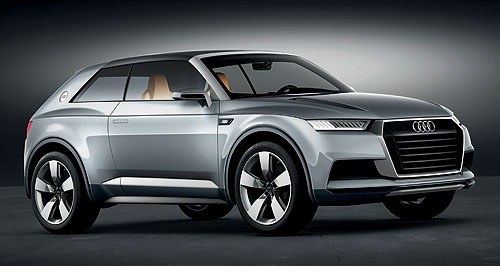Make / Model Search
Future models - Audi - Q2Paris show: Audi concept previews ‘Q2’ SUVCrossing over: Audi’s Crosslane Coupe concept set the scene for the upcoming Q2 when it made its debut at the Paris motor show three years ago. Audi’s hi-tech Crosslane Coupe concept points to sub-Q3 SUV, future Q family design28 Sep 2012 By TERRY MARTIN THE Audi new-model juggernaut has continued at the Paris motor show this week with the unveiling of a compact SUV concept – dubbed the Crosslane Coupe – that previews the long-awaited all-new Q2. The prize piece in the German marque’s motor show menagerie in the French capital, the Crosslane Coupe is a size down from the current Q3, resting on a 2560mm wheelbase and measuring 4210mm long, 1880mm wide and 1410mm high. In comparison, the Q3 has a 2603mm wheelbase, stretches to 4385mm and stands as tall as 1590mm, while its overall width is 1831mm – slightly narrower than the Crosslane concept, which has a low, wide stance and styling cues that Audi has confirmed provide a “foretaste” of next-generation Q family styling in the not-too-distant future. Expected to reach production by 2015 as a rival to the Mini Countryman and other European city SUVs, the Q2 will be underpinned by the Volkswagen Group’s new MQB platform, and in concept form at Paris has emerged with Audi’s new dual-mode plug-in hybrid powertrain that was previewed prior to the show with the latest A1 e-tron prototype. As with the light-sized e-tron, the Crosslane carries a 95kW/200Nm 1.5-litre three-cylinder TFSI petrol engine that works in concert with two electric motors (50kW/210Nm and 85kW/210Nm), a 17.4kWh lithium-ion battery pack and single-stage transmission. The total system power output is 130kW, which is enough to propel the 1390kg Crosslane from 0-100km/h in 8.6 seconds – or 9.8 seconds in pure-electric mode. Top speed is 182km/h. Audi claims further that the Crosslane Coupe is capable of achieving outstanding combined-cycle fuel economy of 1.1 litres per 100km, and CO2 emissions of just 26 grams per kilometres. The result, according to the car-maker, is a “cosmopolitan vehicle that will appeal to young, sporty customers in particular”. The 2+2-seat concept’s removable roof and customisation options are evidence of this, along with the engineering of selectable ‘cruise’ and ‘race’ driving modes. The German manufacturer emphasises the use of three materials to construct what it calls a ‘Multimaterial Space Frame’ – that is: aluminium, which forms a continuous, rigid structure around the occupant cell carbon-fibre-reinforced polymer (CFRP), which is used for the front and rear crumple zones, and the removable roof portions, among other areas and glass-fibre-reinforced polymer (GFRP), which is largely used for surface components. Interestingly, Audi’s designers have formed the trademark single-frame grille as part of the Multimaterial Space Frame. Other design elements of note include trapezoidal headlights with ‘matrix’ LED technology, gaping smooth-surfaced air intakes built into the front bumper, strong horizontal lines along the flanks, muscular rear fenders, huge doors and high window sills that accentuate the low ‘greenhouse’ and coupe-like roofline (hence the concept name). At the rear, the tail-lights are a variation on the motif of the headlights and the bumper incorporates a large aluminium diffuser. The interior continues the theme presented outside with the use of hi-tech materials – CFRP is used extensively, for example – and basic, sporting design cues, plus the expected high degree of connectivity and interaction between driver and machine. A full range of conventional petrol and diesel powertrains driving the front and all four wheels is a sure bet for the production version, although count on hybrid being in the mix as well.  Read more21st of September 2012  Audi re-jigs A1 e-tron hybridBoot-mounted rotary range-extender binned for Audi’s A1 e-tron prototype21st of September 2012  Audi developing electric turboElectric turbocharger eliminates lag, produces less heat than twin-turbos: Audi21st of September 2012  Paris show: 221kW Audi S3 punches above its weightFast yet frugal Audi S3 hot hatch features new 221kW/380Nm 2.0 turbo fourAll future models Alfa Romeo Alfa Romeo Abarth Abarth Audi Audi Aston Martin Aston Martin BMW BMW Bentley Bentley Chrysler Chrysler Chevrolet Chevrolet Dodge Dodge Citroen Citroen Ferrari Ferrari DS DS Ford Ford Fiat Fiat FPV FPV Foton Foton Haval Haval Great Wall Great Wall Honda Honda Holden Holden Hyundai Hyundai HSV HSV Isuzu Isuzu Infiniti Infiniti Jeep Jeep Jaguar Jaguar Lamborghini Lamborghini Kia Kia Lexus Lexus Land Rover Land Rover Mazda Mazda Maserati Maserati Mercedes-Benz Mercedes-Benz McLaren McLaren Mini Mini Nissan Nissan Mitsubishi Mitsubishi Peugeot Peugeot Opel Opel Proton Proton Porsche Porsche Renault Renault Ram Ram Saab Saab Rolls-Royce Rolls-Royce Smart Smart Skoda Skoda Subaru Subaru SsangYong SsangYong Tesla Tesla Suzuki Suzuki Toyota Toyota Volvo VolvoQ2 pricing
Motor industry news |
Click to shareAudi modelsResearch Audi All future models Alfa Romeo Alfa Romeo Abarth Abarth Audi Audi Aston Martin Aston Martin BMW BMW Bentley Bentley Chrysler Chrysler Chevrolet Chevrolet Dodge Dodge Citroen Citroen Ferrari Ferrari DS DS Ford Ford Fiat Fiat FPV FPV Foton Foton Haval Haval Great Wall Great Wall Honda Honda Holden Holden Hyundai Hyundai HSV HSV Isuzu Isuzu Infiniti Infiniti Jeep Jeep Jaguar Jaguar Lamborghini Lamborghini Kia Kia Lexus Lexus Land Rover Land Rover Mazda Mazda Maserati Maserati Mercedes-Benz Mercedes-Benz McLaren McLaren Mini Mini Nissan Nissan Mitsubishi Mitsubishi Peugeot Peugeot Opel Opel Proton Proton Porsche Porsche Renault Renault Ram Ram Saab Saab Rolls-Royce Rolls-Royce Smart Smart Skoda Skoda Subaru Subaru SsangYong SsangYong Tesla Tesla Suzuki Suzuki Toyota Toyota Volvo VolvoQ2 pricing
Motor industry news |






























Facebook Twitter Instagram